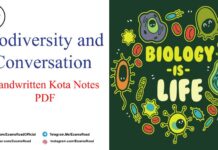NCERT Solutions for Class 11 Biology
NCERT Solutions for Class 11 Biology: NCERT Solutions for Class 11 Biology Chapter 1 The Living World is given below to Study online or download in PDF format free updated for new academic session 2020-2021.
Solutions for NCERT Class 11 are considered to be extremely helpful when preparing for your examinations as well as competitive exams. Solutions have been solved skillfully with the use of an easily comprehensible language to help understand concepts and remember it for a long time.
[su_box title=”1. Why are living organisms classified?”]Solution: Earth consists of millions of organisms, and we might be knowing the plants and animals that reside near us by their local names. These local names would vary from place to place, even within a country. This would lead to confusion in identifying and studying specific species. Hence, to standardise the naming and studying of living organisms it should be called by a common name throughout the world. To achieve this, the organisms are named and classified, according to their characters.[/su_box]
[su_box title=”2. Why are the classification systems changing every now and then?”]Solution: Millions of plants, animals, and microorganisms are found on earth. Many of these have been identified by the scientists while many new species are still being discovered around the world. Therefore, to classify these newly discovered species, new systems of classification have to be devised every now and then. This creates the requirement to change the existing systems of classification.[/su_box]
[su_box title=”3. What different criteria would you choose to classify people that you meet often?”]Solution: We classify the people that we often meet on the following attributes
1)Gender
2)Skin colour
3)Education
4)Profession
5)Hobbies
6)Nature[/su_box]
[su_box title=”4. What do we learn from the identification of individuals and populations?”]Solution: By identifying individuals and populations, we learn the following things :
1.Sex
2.Skin
3.colour
4.Native place
5.Mother tongue
6.Food habit
7.Religion Caste[/su_box]
[su_box title=”5. Given below is the scientific name of Mango. Identify the correctly written name. Mangifera Indica Mangifera indica”]Solution: In binomial system of nomenclature, the generic name of a species always starts with a capital letter whereas the specific name starts with a small letter. Therefore, the correct scientific name of Mango is Mangifera indica.[/su_box]
[su_box title=”6. Define a taxon. Give some examples of taxa at different hierarchical levels.”]Solution: Each unit or category of classification is termed as a taxon. It represents a rank. For example, the basic level of classification is species, followed by genus, family, order, class, phylum or division, in ascending order. The highest level of classification is known as kingdom.[/su_box]
[su_box title=”7. Can you identify the correct sequence of taxonomical categories?
(a) Species Order Phylum Kingdom
(b) Genus Species Order Kingdom
(c) Species Genus Order Phylum”]Solution: Option a) and c) are the correct sequence of taxonomical categories.[/su_box]
[su_box title=”8. Try to collect all the currently accepted meanings for the word ‘species’. Discuss with your teacher the meaning of species in case of higher plants and animals on one hand, and bacteria on the other hand.”]Solution: In biological terms, species is the basic taxonomical rank. It can be defined as a group of similar organisms that are capable of interbreeding under natural conditions to produce fertile offspring. Therefore, a group of similar individuals that are respectively isolated form a species. Species can also be defined as group of individuals that share the same gene pool.[/su_box]
[su_box title=”9. Define and understand the following terms:
(i) Phylum
(ii) Class
(iii) Family
(iv) Order
(v) Genus”]Solution: i) Phylum is a taxonomical hierarchy below Kingdom and above Class. It is a taxon with one or more classes organisms with similar characters.
ii) Class is a taxonomical hierarchy higher than Order and lower than Phylum. Class includes related to orders of the organisms. Example: Presence of notochord in mammals.
iii) Family has a group of related genera with still less number of similarities as compared to genus and species. Example: Fox and dog belongs to the same family. It is a group of entities below Order and above Genus.
iv) Order is a taxon below higher than Family and lower than class. Order being a higher category is the assemblage of families which exhibit a few similar characters.
v) Genus comprises a group of related species which has more characters in common in comparison to species of other genera. Ex: Lion, tiger and leopard are classified under genus Panthera. It is above species and below family.[/su_box]
[su_box title=”10. How is a key helpful in the identification and classification of an organism?”]Solution: Key is another taxonomical aid used for identification of plants and animals based on the similarities and dissimilarities. The keys are based on the contrasting characters generally in a pair called couplet. It represents the choice made between two opposite options. This results in acceptance of only one and rejection of the other. Each statement in the key is called a lead. Separate taxonomic keys are required for each taxonomic category such as family, genus and species for identification purposes. Keys are generally analytical in nature.
Flora, manuals, monographs and catalogues are some other means of recording descriptions. They also help in correct identification. Flora contains the actual account of habitat and distribution of plants of a given area. These provide the index to the plant species found in a particular area. Manuals are useful in providing information for identification of names of species found in an area. Monographs contain information on any one taxon.[/su_box]

















